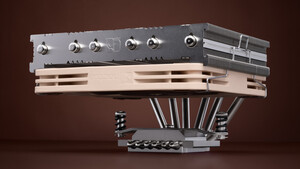perfekt!57
Commodore
- Registriert
- Feb. 2003
- Beiträge
- 4.207
gibt es seit 14. 12.04 (und leider nur auf Englisch) hier:
http://www.lostcircuits.com/motherboard/asus_p5ad2e/10.shtml
Achtung: Vorsicht! Ich bin mir bzgl. nachstehender Ausführungen/Auszüge aus dem Review bzgl. des verwendeten Prozessor-Typs überhaupt nicht mehr sicher! Möglicherweise gilt alles gesagte tatsächlich nur für die (natürlich) veraltete CPU vom Typ 560.
Ich fand dies Review unter anderem deshalb sehr interessant, da man, wie man im Fazit schreibt, beobachtet haben will, dass der verwendete Prescott (wohl leider doch nur ein 560 mit D-Stepping) mit normaler Kühlung überhaupt nicht von der Krankheit des Selbst-Herunterregelns zu heilen sei, da, so "LostCircuits" das Problem der Überhitzung, welches zum Herunterregeln führe ("thermal throttling"), eine Frage des Prescott-Kerns an sich sei, d.h. eine mangelnde Wärmeabgabefähigkeit des Kerns (DIEs) in sich selbst bestehe. (Und das ist nichts wirkliches ganz Neues für das alte Stepping. Sorry dafür. Höchstens klar ausgesprochen.)
Und dies obwohl INTEL beim Prescott dazu übergegangen sein, die den CPU-Kern abdeckende Blechhülle ("Heatspreader") neuerdings direkt auf das DIE aufzulöten - und zwar mit einem, wie ich verstehe, besonders wärmeleitfähigen Lot mit niedrigerer Schmelztemperatur als üblich (Ein Ablösen des Heatspreaders führte also unweigerlich zur Zerstörung des DIE. Und vermutlich tritt/träte auch Selbstzerstörung des Kerns durch Überhitzung beim Prescott 3,8/570J schon bei niedrigeren Temperaturen auf, als bei anderen Intel CPUs (560 z.B.?)). Und auch diese Massnahme alleine sei lange noch nicht ausreichend, so "LostCircuits" als Fazit der durchgeführten Tests:
"Intel has already taken the appropriate measures by moving from a standard thermal interface material to a low melting temperature solder (with the side-effect that it is no longer possible to remove the slug without damaging the processor) but it is still not enough to keep the temperature at the die's hottest spot below the throttling threshold."
Daraus ergeben sich na klar auch für das genannte Asus-Board Ungereimtheiten im Betrieb, zumindest wenn man eine Standardkühlung benutzt. Den dann regelt die CPU seltstätig wegen "Überhitzung" herunter, z.B. bevor man überhaupt nur an ein richtiges OC hätte denken können, bzw. die Regelcharakteristiken von Board und CPU überschneiden sich, ohne das man im aktuellen Bios des Boards "weit genug auf Handbetrieb umschalten könne um das zu vermeiden":
Wie das (ansonsten und wohl sehr zu Recht hochgelobte) Board sich mit dieser CPU @Vapochil oder @LN2 geben würde, ("thermal throttling" dann ja wohl passé?) kann wohl im Moment nur gemutmasst werden, gälte es zu erproben.
Weiteres aus dem Fazit: "It is a strange situation for the conclusion of a review. On the one hand, there is one of the best pieces of hardware , including the bundle, that we have ever laid our hands on, on the other hand, there are the issues of thermal management and throttling that prevent the new platform from even getting the feet on the ground to use the performance that the processor, chipset (including memory subsystem) and the PCIe graphics interface have. ...
Arguably, the P4 is not the greatest performer in a number of applications, particularly when it comes to gaming, however, it is better than what the benchmarks suggest, because whatever we see is only a fraction of what the real performance could be, would it be unfettered from the constraints of throttling.
ASUS is still going in the right direction with the AI-NOS configuration but they stopped halfway by not allowing a combination of user definitions combined with the Overclocking options. If the BIOS settings could be extended to allow the user for manual settings of some baseline parameters, e.g. the memory frequency, the AI NOS could be redirected to become a power-management feature to keep the idle temperature of the CPU (and the HSF) as low as possible, which then would increase the temperature delta to the point of where throttling kicks in. " (Das aber keine wirkliche Lösung für die Überhitzungsprobleme, p. : nur bessere Kühlung hülfe)
Throttling of the CPU occurs almost regardless of the cooling solution used, since the core is no longer capable of dissipating the heat through the integrated heatspreader at the same rate as it is generated. Intel has already taken the appropriate measures by moving from a standard thermal interface material to a low melting temperature solder (with the side-effect that it is no longer possible to remove the slug without damaging the processor) but it is still not enough to keep the temperature at the die's hottest spot below the throttling threshold.
There are two severe consequences, namely that there is no point in increasing the clock speed of the P4 any further even if the processor itself is capable of handling that frequency. In addition, the thermal problems will impact any test results, including heatsink and thermal interface material testing. That means that the thermal read-out differences between different heatsink designs will become negligible, the only thing that varies will be the time until throttling occurs and even those delays will become somewhat uniform with the fast transients of the prescott.
"In addition, the thermal problems will impact any test results". Heißt: Alle gemessenen Benchmarks sind mit einiger Vorsicht zu genießen, da die Testdurchführer sich nie ganz sicher waren darüber, wie weit die CPU sich eigentlich selbst heruntergeregelt habe/hatte, und daher zu niedrige Messungergebnisse die Folge waren.
Soweit dazu:
Ich will mir ja beides (resp. eine ähnliche Kombination) zu Testzwecken nach wie vor zulegen. Prescott 570J und Asus P5AD2-E Premium. Mal sehen, wie sich alles unter Vapochil oder LN2 verhält/verhielte.
p.
"der direkte Link zum Throttling":
http://www.lostcircuits.com/motherboard/asus_p5ad2e/9.shtml
"It is obvious that there is no real correlation between the different CPU speed settings and the results and in order to get to the bottom of this, we ran Panopsys ThrottleWatch in the background:




Top Row: Left: 14 x 266 MHz (3.74 GHz) - Right: 14 x 275 MHz - - Bottom Row: Left: 14 x 200 MHz AI NOS - Right: 15 x 200 MHz AI NOS.
The Throttlewatch traces explain the results we got at the different settings in 3DMark2001SE. Higher clock speed increases the amount of throttling, which, in turn, causes lower benchmark results. The approximate cutoff frequency (with an open case at 67 degrees ambient room temperature) is at about 3.4 GHz. Beyond that, the performance started to deteriorate. More powerful cooling solutions may slightly shift this point but the key issue remains that no matter what cooling solution is used, there will be some throttling and that will effectively cap the highest attainable clock speed - even if it is possible to run the CPU at that frequency - because internally, the clocks will be turned off as soon as the PROCHOT signal is asserted. Since all benchmarks are one way or the other influenced by throttling, they are meaningless and, therefore, we'll leave it at that."
Mehr als 3,4 Gigahertz waren also selbst mit offenem Gehäuse hier nicht herauszuholen. Die eigentlich Leistungsspitze des Prescott wird abgeschnitten (cap = "kappen").
.
Das neue E-Stepping welches mit dem Prescott 570J kam, wird also analog zu untersuchen sein, ob ähnliche Effekte auftreten und in welchem Maße.
.
http://www.lostcircuits.com/motherboard/asus_p5ad2e/10.shtml
Achtung: Vorsicht! Ich bin mir bzgl. nachstehender Ausführungen/Auszüge aus dem Review bzgl. des verwendeten Prozessor-Typs überhaupt nicht mehr sicher! Möglicherweise gilt alles gesagte tatsächlich nur für die (natürlich) veraltete CPU vom Typ 560.
Ich fand dies Review unter anderem deshalb sehr interessant, da man, wie man im Fazit schreibt, beobachtet haben will, dass der verwendete Prescott (wohl leider doch nur ein 560 mit D-Stepping) mit normaler Kühlung überhaupt nicht von der Krankheit des Selbst-Herunterregelns zu heilen sei, da, so "LostCircuits" das Problem der Überhitzung, welches zum Herunterregeln führe ("thermal throttling"), eine Frage des Prescott-Kerns an sich sei, d.h. eine mangelnde Wärmeabgabefähigkeit des Kerns (DIEs) in sich selbst bestehe. (Und das ist nichts wirkliches ganz Neues für das alte Stepping. Sorry dafür. Höchstens klar ausgesprochen.)
Und dies obwohl INTEL beim Prescott dazu übergegangen sein, die den CPU-Kern abdeckende Blechhülle ("Heatspreader") neuerdings direkt auf das DIE aufzulöten - und zwar mit einem, wie ich verstehe, besonders wärmeleitfähigen Lot mit niedrigerer Schmelztemperatur als üblich (Ein Ablösen des Heatspreaders führte also unweigerlich zur Zerstörung des DIE. Und vermutlich tritt/träte auch Selbstzerstörung des Kerns durch Überhitzung beim Prescott 3,8/570J schon bei niedrigeren Temperaturen auf, als bei anderen Intel CPUs (560 z.B.?)). Und auch diese Massnahme alleine sei lange noch nicht ausreichend, so "LostCircuits" als Fazit der durchgeführten Tests:
"Intel has already taken the appropriate measures by moving from a standard thermal interface material to a low melting temperature solder (with the side-effect that it is no longer possible to remove the slug without damaging the processor) but it is still not enough to keep the temperature at the die's hottest spot below the throttling threshold."
Daraus ergeben sich na klar auch für das genannte Asus-Board Ungereimtheiten im Betrieb, zumindest wenn man eine Standardkühlung benutzt. Den dann regelt die CPU seltstätig wegen "Überhitzung" herunter, z.B. bevor man überhaupt nur an ein richtiges OC hätte denken können, bzw. die Regelcharakteristiken von Board und CPU überschneiden sich, ohne das man im aktuellen Bios des Boards "weit genug auf Handbetrieb umschalten könne um das zu vermeiden":
Wie das (ansonsten und wohl sehr zu Recht hochgelobte) Board sich mit dieser CPU @Vapochil oder @LN2 geben würde, ("thermal throttling" dann ja wohl passé?) kann wohl im Moment nur gemutmasst werden, gälte es zu erproben.
Weiteres aus dem Fazit: "It is a strange situation for the conclusion of a review. On the one hand, there is one of the best pieces of hardware , including the bundle, that we have ever laid our hands on, on the other hand, there are the issues of thermal management and throttling that prevent the new platform from even getting the feet on the ground to use the performance that the processor, chipset (including memory subsystem) and the PCIe graphics interface have. ...
Arguably, the P4 is not the greatest performer in a number of applications, particularly when it comes to gaming, however, it is better than what the benchmarks suggest, because whatever we see is only a fraction of what the real performance could be, would it be unfettered from the constraints of throttling.
ASUS is still going in the right direction with the AI-NOS configuration but they stopped halfway by not allowing a combination of user definitions combined with the Overclocking options. If the BIOS settings could be extended to allow the user for manual settings of some baseline parameters, e.g. the memory frequency, the AI NOS could be redirected to become a power-management feature to keep the idle temperature of the CPU (and the HSF) as low as possible, which then would increase the temperature delta to the point of where throttling kicks in. " (Das aber keine wirkliche Lösung für die Überhitzungsprobleme, p. : nur bessere Kühlung hülfe)
Throttling of the CPU occurs almost regardless of the cooling solution used, since the core is no longer capable of dissipating the heat through the integrated heatspreader at the same rate as it is generated. Intel has already taken the appropriate measures by moving from a standard thermal interface material to a low melting temperature solder (with the side-effect that it is no longer possible to remove the slug without damaging the processor) but it is still not enough to keep the temperature at the die's hottest spot below the throttling threshold.
There are two severe consequences, namely that there is no point in increasing the clock speed of the P4 any further even if the processor itself is capable of handling that frequency. In addition, the thermal problems will impact any test results, including heatsink and thermal interface material testing. That means that the thermal read-out differences between different heatsink designs will become negligible, the only thing that varies will be the time until throttling occurs and even those delays will become somewhat uniform with the fast transients of the prescott.
"In addition, the thermal problems will impact any test results". Heißt: Alle gemessenen Benchmarks sind mit einiger Vorsicht zu genießen, da die Testdurchführer sich nie ganz sicher waren darüber, wie weit die CPU sich eigentlich selbst heruntergeregelt habe/hatte, und daher zu niedrige Messungergebnisse die Folge waren.
Soweit dazu:
Ich will mir ja beides (resp. eine ähnliche Kombination) zu Testzwecken nach wie vor zulegen. Prescott 570J und Asus P5AD2-E Premium. Mal sehen, wie sich alles unter Vapochil oder LN2 verhält/verhielte.
p.
"der direkte Link zum Throttling":
http://www.lostcircuits.com/motherboard/asus_p5ad2e/9.shtml
"It is obvious that there is no real correlation between the different CPU speed settings and the results and in order to get to the bottom of this, we ran Panopsys ThrottleWatch in the background:




Top Row: Left: 14 x 266 MHz (3.74 GHz) - Right: 14 x 275 MHz - - Bottom Row: Left: 14 x 200 MHz AI NOS - Right: 15 x 200 MHz AI NOS.
The Throttlewatch traces explain the results we got at the different settings in 3DMark2001SE. Higher clock speed increases the amount of throttling, which, in turn, causes lower benchmark results. The approximate cutoff frequency (with an open case at 67 degrees ambient room temperature) is at about 3.4 GHz. Beyond that, the performance started to deteriorate. More powerful cooling solutions may slightly shift this point but the key issue remains that no matter what cooling solution is used, there will be some throttling and that will effectively cap the highest attainable clock speed - even if it is possible to run the CPU at that frequency - because internally, the clocks will be turned off as soon as the PROCHOT signal is asserted. Since all benchmarks are one way or the other influenced by throttling, they are meaningless and, therefore, we'll leave it at that."
Mehr als 3,4 Gigahertz waren also selbst mit offenem Gehäuse hier nicht herauszuholen. Die eigentlich Leistungsspitze des Prescott wird abgeschnitten (cap = "kappen").
.
Das neue E-Stepping welches mit dem Prescott 570J kam, wird also analog zu untersuchen sein, ob ähnliche Effekte auftreten und in welchem Maße.
.
Zuletzt bearbeitet:



